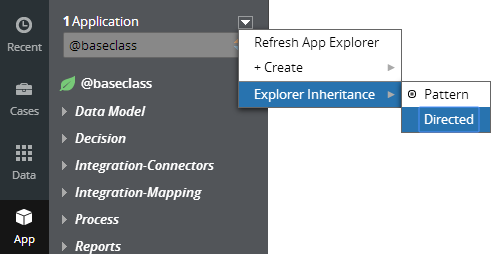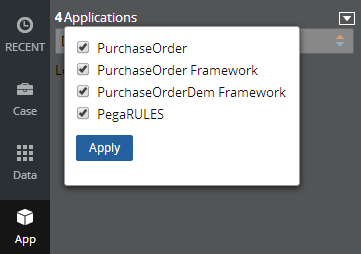Guardrails compliance score
Valid from Pega Version 7.1.5
The Application Guardrails landing page has been enhanced to help you build more guardrail-compliant applications. Increase transparency and accountability on your projects by responding to the following compliance score metrics:
- A weighted compliance score (0-100) based on warnings, severity, and justification
- A percentage of compliant rules in your application
- Total number of rules in your application
- Total number of rules in your application with warnings (justified and unjustified)
Additional metrics include alert and interaction count trends over the last four weeks.
For more information, see Guardrails compliance score.
Directed inheritance view in Application Explorer
Valid from Pega Version 7.1.5
You can now specify which inheritance model is used to populate classes in the Application Explorer. From the top level menu, use the “Explorer Inheritance” option to choose between:
- Pattern: only display class names whose prefix matches the root node class name.
- Directed: first display classes that explicitly name the root node as the parent class; then display classes with pattern inheritance.

By default, the Application Explorer loads using Pattern inheritance.
Save Application Explorer filter selections
Valid from Pega Version 7.1.5
Application scoping control selections made in the Application Explorer are now persisted between sessions. These preferences are stored in an operator record on an access group level. If you delete (and later re-add) an access group on your operator form, the application scoping control defaults to all layers selected:

External access control DASS
Valid from Pega Version 7.1.5
A new Dynamic Admin System Setting (DASS) controls the Designer Studio's access to external systems, specifically the PDN RSS feed found on the home page.
By default, Pega-Desktop.AllowAccessToExternalSystem is set to TRUE. Update this setting to FALSE to hide the PDN RSS feed and ensure that no RSS fetch is performed.
Compare rule versions in a rule form
Valid from Pega Version 7.2.2
You can now compare different versions of rules from the menu when you work within a rule form instead of using the Rule Compare utility. You can inspect changes that were made between versions directly on the rule form, make updates, and save any changes to the rule form.
For more information, see Rule version comparison within a rule form.
View all nodes in a cluster from the Cluster Management landing page
Valid from Pega Version 7.2.2
Use the Cluster Management page to view information for all of the available nodes in a cluster. To view the nodes, click . To access detailed information about a single node, click Actions.
For more information, see System Operations.
Logic-based assignment routing
Valid from Pega Version 7.2.2
You can now define business logic that controls when and by whom an assignment is processed in a case. By routing assignments to a specific user or group of users, you can help ensure that cases are resolved faster.
For more information, see Logic-based assignment routing.
Support for additional rule types for PegaUnit test cases
Valid from Pega Version 7.2.2
To compare the expected results with the results that are returned by running a rule, you can now create PegaUnit test cases for the following rule types:
- Activities
- Data transforms
- Strategies
- Decision trees
- Decision tables
After you unit test these rules, you can convert them to test cases and configure assertions on the test cases. You can also set up the clipboard with data before tests are run, and clean up the clipboard after tests are run.
For more information, see PegaUnit testing.
Page assertions are supported for PegaUnit test cases
Valid from Pega Version 7.2.2
You can now create page assertions for PegaUnit test cases. Because data transforms and activities can create or remove pages, you can configure page assertions to determine whether a page exists after you run PegaUnit test cases.
For more information, see Configuring page assertions.
New Automated Testing landing page
Valid from Pega Version 7.2.2
The new Automated Testing landing page displays all the PegaUnit test cases in your application. You can use it to quickly access, run, and view results of tests. In addition, if you have the AutomatedTesting privilege enabled, you can switch to the Automated Unit Testing landing page to access rules that are supported by both PegaUnit testing and Automated Unit Testing, such as activities.
For more information, refer to Automated Testing landing page.

